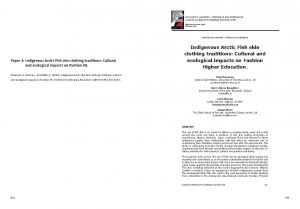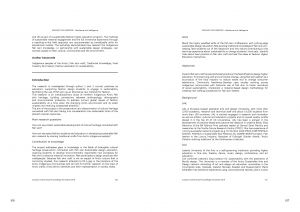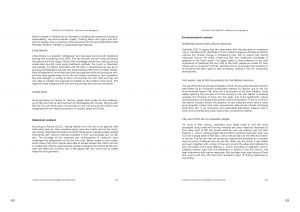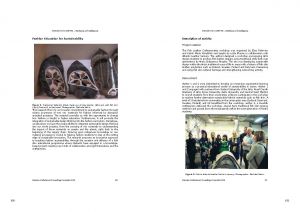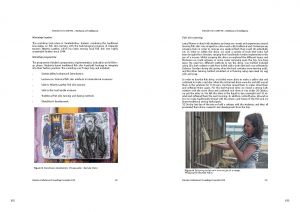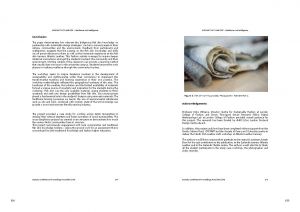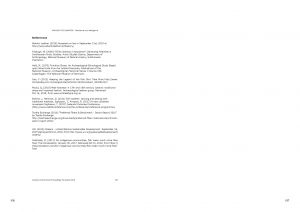Palomino, E. Rahme, L. Karadottir, K. (2019) Indigenous Arctic Fish skin clothing traditions: Cultural and ecological impacts on Fashion HE. CUMULUS Conference Rovaniemi. ISBN 978-952-337-158-3.
The use of fish skin is an ancient tradition in societies along rivers and coasts
around the world and there is evidence of fish skin leather production in
Scandinavia, Alaska, Hokkaido, Japan, northeast China and Siberia.For Arctic
indigenous people, their relationship with fish plays an important role in
maintaining their identities creating important ties with the environment. The
Arctic is undergoing dramatic climate changes threatening indigenous people,
impacting their food security and traditional knowledge systems as they rely on
fishing activities for their physical, cultural and spiritual well-being.
This research looks at how the use of fish skin by aboriginal Arctic people has
recently been assimilated as an innovative sustainable material for fashion due
to their low environmental impact. Fish skins are sourced from the food industry,
using waste, applying the principle of circular economy. This paper describes the
Fish skin workshop delivered at the world’s biggest fish skin tannery: Atlantic
Leather in Iceland, where an experienced Swedish craftsperson passed down
the endangered Arctic fish skin craft to the next generation of Nordic students
from universities in the circumpolar area (Iceland, Denmark, Sweden, Finland)
and UK as part of a sustainable fashion higher education program. The methods
of sustainable material engagement and the full immersive experience through
a teaching-in-the field approach are recommended as transferable skills for
educational models. The workshop demonstrates how relevant the Indigenous
fish skin knowledge -in partnership with sustainable design strategies- can
connect people to their culture, communities and the environment.
- Palomino, E., Pardue, J., Donkan, A. (2023) Fish skin Peoples of the Bering Strait: Encounters in Hokkaido, Japan. Smithsonian Institution National Museum of natural History. Arctic Studies Center Newsletter. May 2023. N.30. pp.74-75
- Palomino, E. (2022) Indigenous Arctic Fish Skin Heritage: Sustainability, Craft and Material Innovation. PhD Thesis. University of the Arts, London.
- Palomino, E., Cloud, J. (2022) The Arctic as viewed from Florence. Arctic Studies Center Newsletter, Smithsonian National Museum of Natural History.
- Palomino, E. (2021) Fish Skin Coat from the Amur River. TEXT for the Study of the History Art Design of Textiles. V. 48: 2021. The Textiles Society, Pat Frost (ed)
- Trachter, F., Palomino, E., Defeo, G. (2021) Patagonian fish skin tanning processes. XXXVI IULTCS Congress Greening the Leather Value Chain
- Palomino, E., Pardue, J. (2021) Alutiiq Fish Skin Traditions: Connecting Communities in the COVID-19 Era. MDPI Heritage, 4, x. Academic Editor(s): Claire Smith.
- Palomino, E., Pardue, J., (2021) A virtual Alutiiq Fish Skin workshop during Covid-19 times. Smithsonian Institution National Museum of natural History. Arctic Studies Center Newsletter. May 2021. N.30.pp-16-17
- Palomino, E., Freilich, O., Raine, I. (2021) 'A virtual Ainu fish skin workshop during Covid 19'. Global Fashion conference. Academy of Fine Arts of Warsaw. ISBN: 978-989-54263-2-4
- Palomino, E., Karadottir, K. (2021) Fish skin, a historical material assimilated as a sustainable material for fashion. In: Fashion: Culture, Craft, and Identity. Brill.
- Palomino, E., Boon, J. (2020) Preservation of Hezhen Fish Leather tradition through Fashion Education. Textiles, Identity and Innovation. Taylor & Francis.
- Palomino, E. (2020) Fashion workshop in Anchorage. Smithsonian Institution National Museum of natural History. Arctic Studies Center Newsletter. May 2020. N.27.pp. 57-58
- Palomino, E., Karadottir, K., Phirry, E. (2020) Indigenous Fish Skin Craft Revived Through Contemporary Fashion. International Foundation of Fashion Technology Institutes Journal. ISSN: 2694-5193
- Palomino, E. Defeo, G. (2019) Material Design Research - Fish skin, a new environmental -friendly material for fashion. Design Research for Change. Design Museum, London ISBN 978-1-86220-369-3
- Palomino, E. Rahme, L. Karadottir, K. (2019) Indigenous Arctic Fish skin clothing traditions: Cultural and ecological impacts on Fashion HE. CUMULUS Conference Rovaniemi. ISBN 978-952-337-158-3.
- Palomino, E. (2019) SDG 14 Life Below Water Introducing Fish Skin as a Sustainable Raw Material for Fashion. In: Franco I., Chatterji T., Derbyshire E., Tracey J. (eds) Actioning the Global Goals for Local Impact. Science for Sustainable Societies. S

